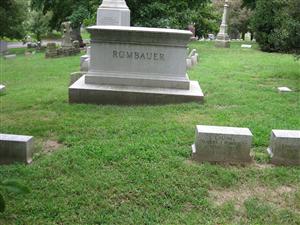
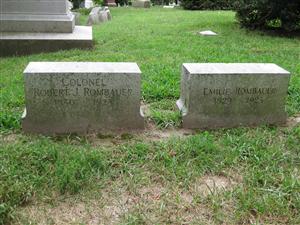
The Robert J. Rombauer Grave [ Waypoint = N38 41.523 W90 14.053 ] is located in Block 24, Lot 2524.
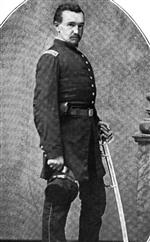
Robert Julius Rombauer was one of four Hungarian-American brothers to serve the Union during the war. Fleeing into exile following the failed 1848 Hungarian Revolution, Rombauer settled in St. Louis in the 1850s. [184]
On May 7, 1861, Lieutenant-Colonel Robert J. Rombauer was appointed second-in-command of the First Regiment, United States Reserve Corps in St. Louis, Missouri. Three days later Rombauer's Regiment was part of the Federal force to surround and capture the Missouri State Guard at Camp Jackson. The soldiers of the First Regiment, USRC were 90-day volunteers and mustered out on August 20, 1861. In September 1861, the regiment reenlisted for 3 years, at which time, Robert J. Rombauer served as its Colonel. In July 1862, a large portion of Rombauer's regiment mutinied, refusing to leave the State of Missouri after being ordered into Arkansas. In July 1862, Rombauer was in command of the Second Brigade, Third Division in Major-General Samuel R. Curtis's Army of the Southwest. His brigade participated in the Army of the Southwest's operations in Arkansas following the Battle of Pea Ridge. The regiment was mustered out of service on October 6, 1862. [185]
Robert J. Rombauer was the author of the book, The Union Cause In St. Louis In 1861: An Historical Sketch, which was published in 1909.
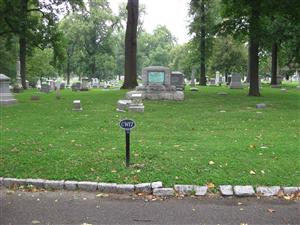
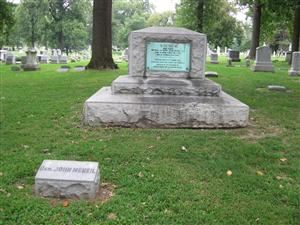
The John McNeil Grave at Bellefontaine Cemetery [ Waypoint = N38 41.591 W90 14.079 ] is located in Block 35, Lot 1103.
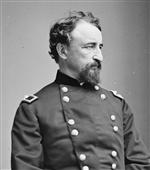
Born in Halifax, Nova Scotia, John McNeil was the son of exiled American Tories. After spending part of his life in the Northeastern United States, McNeil moved to St. Louis, Missouri where he operated a very successful business. Although a Democrat, McNeil stayed loyal to the Union and enlisted in the U. S. Army. He volunteered for three months service on May 8, 1861, becoming the Colonel of the Third Missouri Infantry Regiment, United States Reserve Corps. McNeil would lead this regiment as part of Brigadier-General Nathaniel Lyon's Capture of Camp Jackson. On July 17, 1861, McNeil would lead about 460 of his men against a Missouri State Guard force of about 1,000 under the command of Brigadier-General Thomas Harris. This action took place near Fulton, Missouri resulting in a Federal victory. After assuming command in Missouri, Major-General John C. Fremont appointed Colonel McNeil to be the military commandant of St. Louis. [186]
In 1862, Colonel McNeil was in command of a force of about 1,000 including the Second Missouri Cavalry, a detachment from the Third Iowa Cavalry, and a detachment of the 11th Cavalry, Missouri State Militia. The Federal force was operating in Missouri north of the Missouri River in pursuit of an enemy force under the command of Colonel Joseph C. Porter. Porter's force consisted of between 2,500 and 3,000 poorly trained and poorly equipped new recruits. After pursuing the Confederates for over a week, McNeil’s cavalry force caught up to Porter's force near Kirksville, Missouri. Around 11:00 a.m. on August 6, 1862, McNeil attacked the Confederates who had set up their defenses in the town of Kirksville. Using his artillery to advantage, McNeil's forces overwhelmed the Confederate defenders and forced their retreat while inflicting heavy casualties. J. T. Wallace, one of the new Confederate recruits, later recalled what happened during the fighting: [187]
We . . . marched westward with all convenient haste to Kirksville, which we reached on the forenoon of the 6th. Here Colonel Porter determined to make a stand. I think it was unfortunate that he chose to fight in a town where, on the high open ground, the enemy with their artillery and their long-range guns had all the advantage . . . The Federals were wise enough to keep out of our reach, and they swept the streets and soon knocked to pieces the wooden buildings . . . After about three hours fighting Colonels Porter and Franklin had a consultation and decided to put the Chariton River between us and the enemy. The retreat was at first in pretty good order, but it increased in disorder as the crowd thickened on the narrow road as we approached the river.
Colonel McNeil continued his pursuit of Porter's force, skirmishing with them near Stockton, Missouri and sending the Confederates retreating again. McNeil discovered 26 men in the captured Confederates who had previously taken the loyalty oath and given bonds. McNeil ordered these men to be summarily executed. Next McNeil occupied Palmyra, Missouri on September 12, 1862. In retribution for the abduction and murder of Andrew Allsman, a loyal citizen of Palmyra, McNeil ordered the execution of ten Confederate prisoners on October 18, 1862. This cause a tremendous uproar. Confederate authorities from Jefferson Davis on down demanded an explanation and threatened to execute the next ten Union officers captured, if McNeil was not turned over to the Confederacy for punishment. [188]
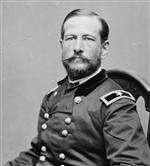
In the fall of 1864, Brigadier-General John McNeil was in command of the District of Rolla, Missouri when Sterling Price invaded Missouri. McNeil took command of the Second Brigade in Major-General Alfred Pleasonton's Provisional Cavalry Division, which was sent out in pursuit of Confederate Major-General Sterling Price's Army of Missouri. On October 22, 1864, Pleasonton' Cavalry finally caught up with Price's rear guard in Independence, Missouri. McNeil's brigade was in the lead and attacked the Confederates in The Second Battle of Independence quickly forcing the Confederate to withdraw west towards Kansas City, Missouri. [189]
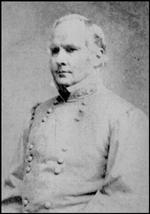
Following the Second Battle of Independence, Major-General Pleasonton ordered Brigadier-General McNeil to take his command and reach New Santa Fe, Missouri by daylight in order to cut off Price's retreat. McNeil came upon Price's wagon train as it was trying to get across the Big Blue River at Russell's Ford. McNeil mistakenly believed he had come upon the entire Confederate army, but it was a single brigade and a large number of unarmed recruits that were escorting the wagon train. McNeil only made a demonstration against the Confederates. Price's wagon train was able to get across the river and get headed south towards safety. Pleasonton was furious and would later press charges against McNeil. McNeil was court-martialed and sentenced to three months suspension of his rank and pay. However, the Judge-Advocate-General later overturned the verdict and reinstated McNeil's rank and pay. Following this McNeil was given command of the District of Central Missouri, which he commanded until the end of the war. [190]
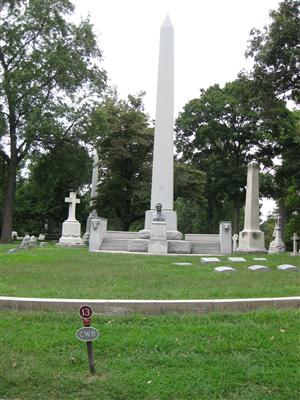
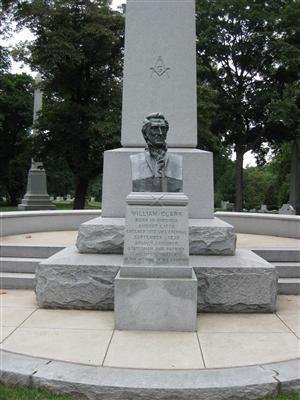
The William Clark Grave at Bellefontaine Cemetery [ Waypoint = N38 41.908 W90 13.779 ] is located in Block 224, Lot 780.
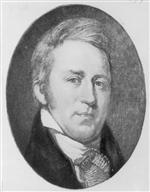
William Clark was not involved in the American Civil War, but he ws such an important historical figure in American History, that I thought you would want to see where he was buried. Besides his son, a Confederate General, is buried here also. William Clark's grave site is marked by a 35 foot tall gray granite obelisk.
Born in Virginia, William Clark at age 14 would move with his family to Kentucky. As a 19 year old Clark would join the State Militia and then the United States Army. From 1803 to 1806, William Clark, along with Meriwether Lewis, led the Lewis and Clark Expedition to explore the Louisiana Purchase. When the Missouri Territory was established in 1813, President James Madison appointed William Clark to be the Territorial Governor. After losing the election to become the first Governor of the State of Missouri in 1820, President James Monroe would appoint Clark to be the country's first Superintendent of Indian Affairs in 1822. He served in this position until his death in 1838.
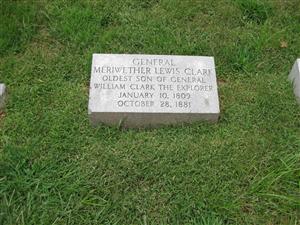
The Meriwether Lewis Clark Grave at Bellefontaine Cemetery [ Waypoint = N38 41.909 W90 13.779 ] is located near his father's obelisk in Block 224, Lot 780.
The oldest son of the famed explorer, William Clark, Meriwether Lewis Clark is buried near his father. Born in St. Louis, Missouri, Clark graduated from the Military Academy at West Point in 1830. He served as a Major of Missouri volunteers during the Mexican-American War.
At the start of the American Civil War, Meriwether Lewis Clark was appointed by Missouri Governor Claiborne Fox Jackson to be Brigadier-General of the Ninth Division in the Missouri State Guard. Towards the end of 1861, Clark resigned his commission in the Missouri State Guard and volunteered for the Confederate Army as a Major of artillery. Clark also served on the staff of Confederate General Braxton Bragg, after which he was in charge of the Ordnance Department in Richmond, Virginia. In 1864, Clark would become a brigade commander in Robert E. Lee's Army of Northern Virginia. Colonel Meriwether Lewis Clark was captured on April 5, 1865 at the Battle of Sayler's Creek. Clark moved to Kentucky after the war. [191]
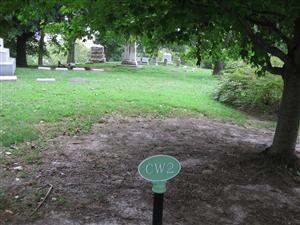
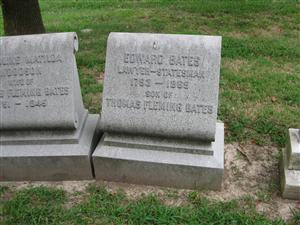
The Edward Bates Grave at Bellefontaine Cemetery [ Waypoint = N38 41.874 W90 13.745 ] is located in Block 223, Lot 1315.
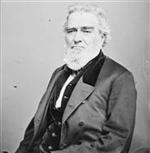
Edward Bates was a Missourian who ran unsuccessfully for the 1860 Republican Presidential nomination. Bates would serve in President Abraham Lincoln's cabinet as the US Attorney general from 1861-1864.
Born in Virginia, Bates moved to St. Louis in the Missouri Territory in 1914 when he was 21 years old. Bates studied and became a lawyer in 1816. In 1820, Edward Bates was elected as one of 41 delegates who would draft the first constitution for the State of Missouri. Bates would serve as the State of Missouri's first Attorney General , was a state legislator and would represent Missouri in the US House of Representatives in 1826 [192]
Bates was a longtime member of the Whig Party, but would join the fledgling Republican Party. In 1860, Edward Bates ran for the Republican Nomination to run for President of the United States. But of course we all know he lost to Abraham Lincoln. After Lincoln was elected President, he would appoint Edward Bates to be his Attorney General, a position that Bates held from 1861 to 1864.
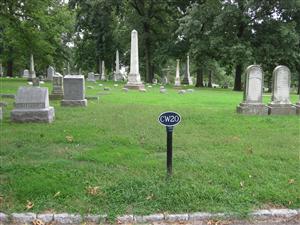
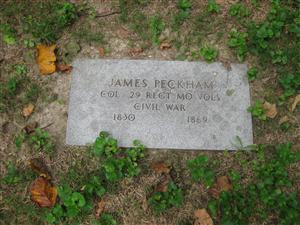
The James Peckham Grave at Bellefontaine Cemetery [ Waypoint = N38 41.757 W90 13.788 ] is located in Block 107, Lot 1540.
James Peckham was a Missouri State legislator in 1861 when the Civil War began. On July 4, 1861, Peckham was mustered into service as a Lieutenant-Colonel, Eighth Missouri Volunteer Infantry Regiment. Peckham was wounded in November 1861 and would resign his commission in January 1862 due to “urgent private business.” Lieutenant-Colonel Peckham led the Eighth Missouri in the Battle of Shiloh as part of Major-General Lew Wallace's Third Division. Peckham also led his regiment during the advance upon and the Siege of Corinth. [193]
Peckham had quite a temper and was involved in a shouting match with his second-in-command, Major John McDonald. After Peckham's resignation on February 1, 1862, Major John McDonald assumed command of the regiment and led it in the Battle of Fort Donelson. A month later, Peckham applied to be recommissioned in the regiment, which was accepted. Lieutenant-Colonel Peckham assumed command of the regiment on March 4, 1862. Resentment of Peckham's reinstatement ended up resulting in a prolonged cursing match to occur between Peckham and McDonald. Peckham placed McDonald under arrest. Following the Battle of Shiloh, Major McDonald was tried before a court-martial for “conduct unbecoming an officer and a gentleman.” Major McDonald was found guilty, but Major-General Henry Halleck rescinded the sentence. Although Lieutenant-Colonel Peckham was not tried before a court-martial for his behavior, he did resign his commission on June 1, 1862. [194]
Next up for Peckham was re-enlisting as the Lieutenant-Colonel of the 29th Missouri Volunteer Infantry Regiment. In September 1862, shortly after receiving his new commission, Peckham was charged by Surgeon E. Kramer, First Wisconsin Cavalry, with making “illegitimate orders” and “conduct unbecoming an officer and a gentleman.” Essentially, Peckham had ordered Kramer to treat a civilian. Kramer refused, saying they were not authorized to treat civilians. Peckham threatened Kramer and then had him arrested, after which Kramer pressed charges against Peckham. Nothing came of this and James Peckham would be promoted to Colonel and assume command of the 29th Missouri Infantry on March 9, 1863. [195]
While serving with the 29th Missouri, Peckham fought in Grant's operations against Vicksburg, Mississippi, as part of the First Brigade in Steele's First Division in Sherman's Fifteenth Army Corps. On November 24, 1863, Peckham was severely wounded at the Battle of Lookout Mountain, Tennessee. Disabled because of his wounds, Colonel Peckham resigned on March 9, 1864. [196]
James Peckham was the author of the book, Gen. Nathaniel Lyon, and Missouri in 1861: A monograph of the Great Rebellion, which was published in 1866.